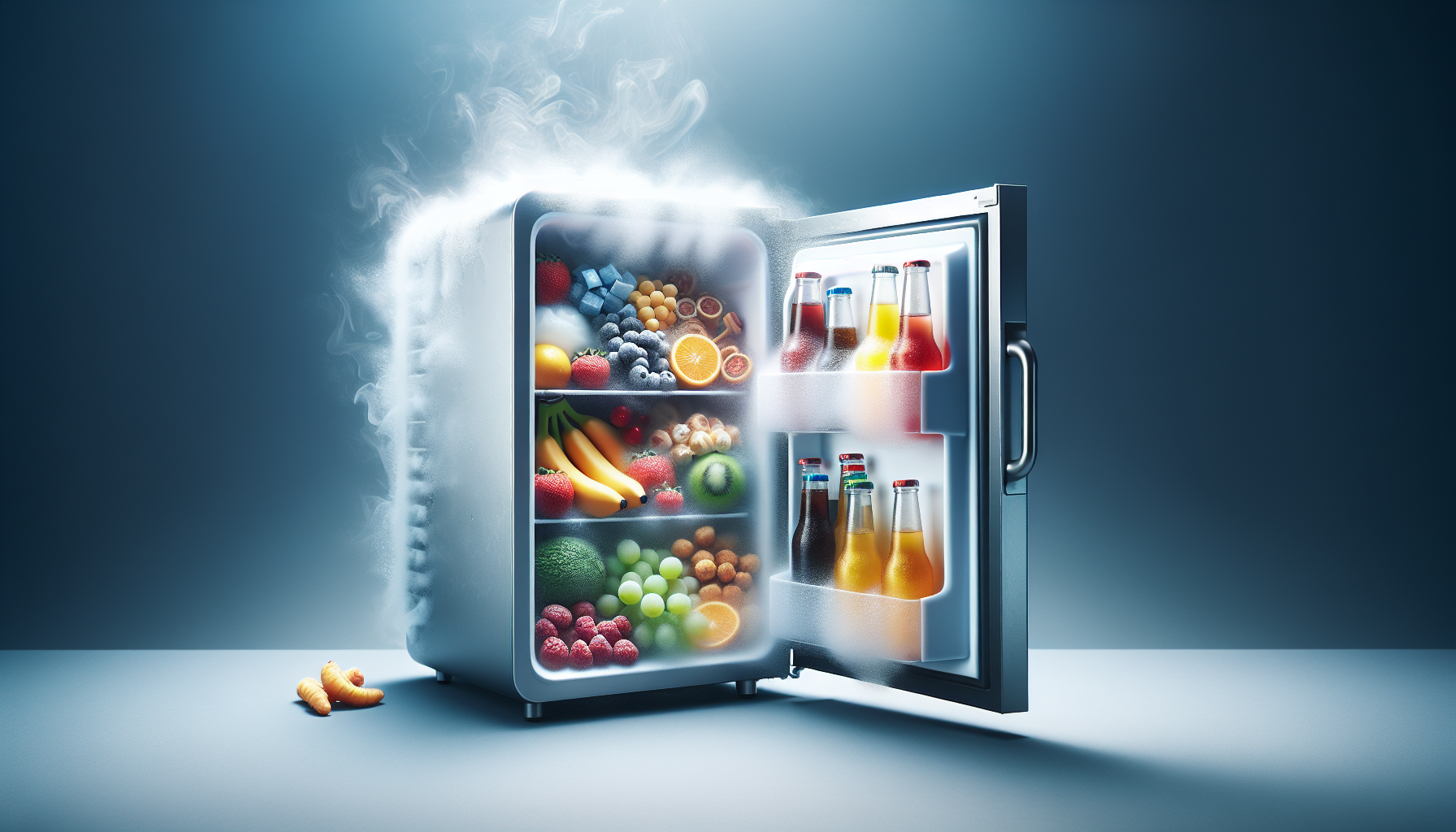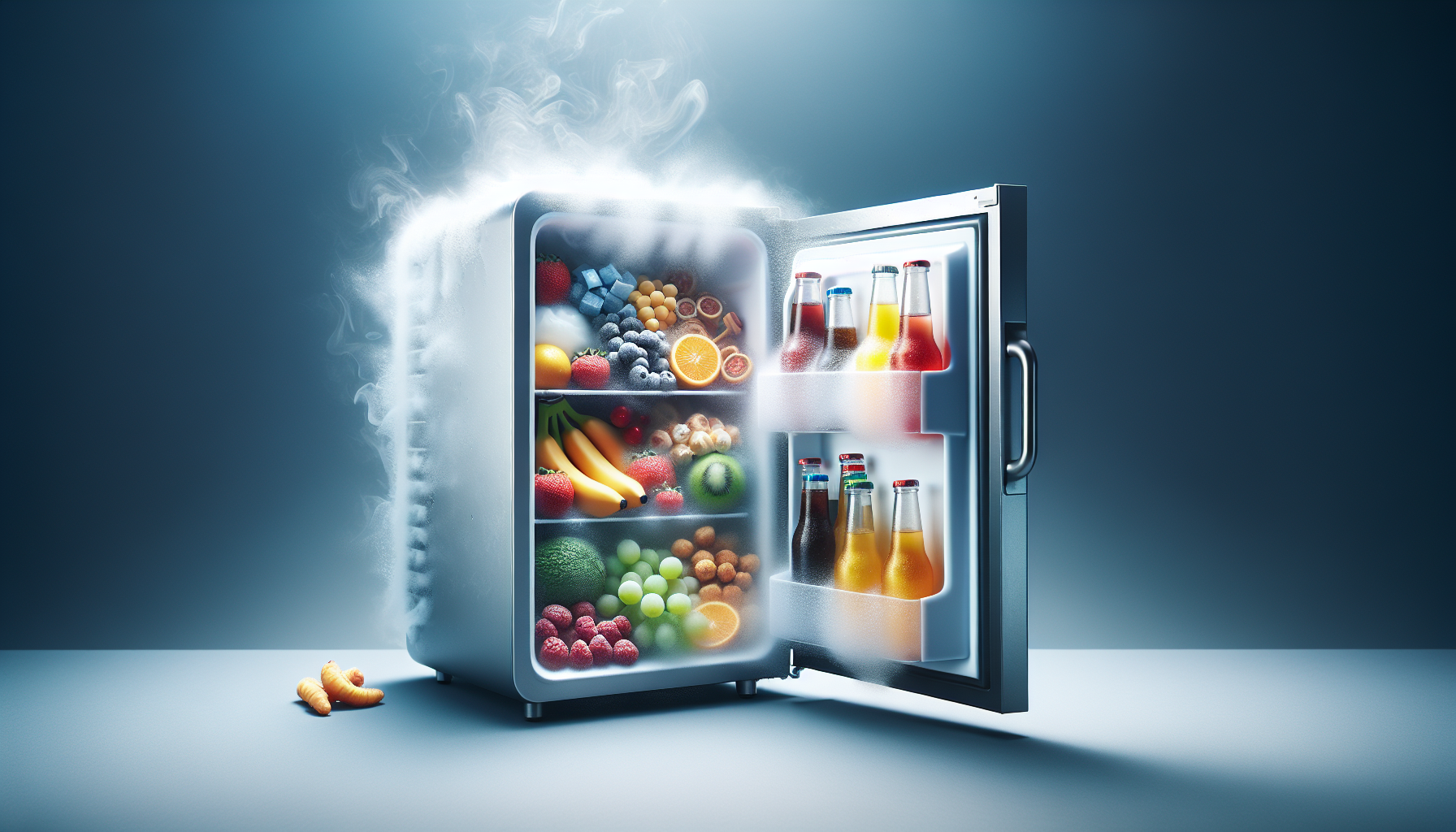Have you ever wondered if mini fridges are effective at keeping your food cold? Whether you’re a student living in a dorm or someone looking for a compact solution to store cold drinks and snacks, mini fridges have become increasingly popular. But how well do they actually work? In this article, we will explore the efficiency of mini fridges in keeping food cold, and provide you with some insights to help you make an informed decision about whether or not to invest in one.

CHECK OUT MINI FRIDGES AND KEGERATORS ON AMAZON
How do mini fridges work?
Mini fridges are compact refrigeration units that are designed to keep food and beverages cold, making them ideal for dorm rooms, offices, and small living spaces. There are three main types of mini fridges: compressor-based, thermoelectric, and absorption. Each of these types operates differently to provide cooling capabilities.
Compressor-based mini fridges
Compressor-based mini fridges work using a refrigeration cycle similar to that of a full-sized refrigerator. They utilize a compressor, condenser, expansion valve, and evaporator to cool the internal compartment. The compressor pressurizes the refrigerant, causing it to release heat as it passes through the condenser. This process cools the refrigerant, which then flows through the expansion valve and evaporator, where it absorbs heat from the interior of the mini fridge, creating a cool environment.
Thermoelectric mini fridges
Thermoelectric mini fridges, on the other hand, use the Peltier effect to generate cooling. This effect occurs when an electric current is passed through two different types of semiconductors, creating a temperature difference between them. One side of the thermoelectric module becomes cooler while the other side becomes hotter. The cooler side of the module is attached to the interior of the mini fridge, effectively cooling the compartment.
Absorption mini fridges
Absorption mini fridges are unique in that they don’t have a compressor or moving parts. Instead, they rely on a combination of heat, chemicals, and gravity to create a cooling effect. These mini fridges use a heat source, such as a propane burner or electric element, to drive a refrigeration cycle. This cycle involves a mixture of refrigerant, water, and an absorbent material that circulates through the system, absorbing heat from the interior and releasing it outside, keeping the mini fridge cool.
Factors affecting the cooling ability of mini fridges
While mini fridges are designed to cool your food and beverages, there are several factors that can affect their cooling ability. Understanding these factors can help you maximize the efficiency of your mini fridge.
Size and capacity
The size and capacity of a mini fridge can significantly impact its cooling ability. Smaller mini fridges generally have less space for air circulation and may struggle to cool items uniformly. It’s important to choose a mini fridge with an appropriate size and capacity for your needs to ensure efficient cooling.
Temperature settings
Most mini fridges offer adjustable temperature settings, allowing you to set the desired cooling level. However, it’s important to note that mini fridges may have limited temperature control compared to full-sized refrigerators. Ensure that you set the temperature to a safe and appropriate level for storing your food.
Insulation
The insulation of a mini fridge plays a crucial role in maintaining the desired temperature. Good insulation helps to keep the cool air inside and prevent warm air from entering the fridge. Make sure to choose a mini fridge with adequate insulation for optimal cooling efficiency.
Placement of the mini fridge
The placement of your mini fridge can affect its cooling ability. It’s important to keep the fridge away from heat sources such as direct sunlight, stoves, or other appliances that generate heat. Placing the mini fridge in a well-ventilated area will also help ensure proper airflow and cooling efficiency.
Understanding temperature zones in mini fridges
Mini fridges often have separate temperature zones for different storage needs. Understanding these temperature zones can help you optimize the organization of your fridge.
Chilling zone
The chilling zone in a mini fridge is designed for items that need to be kept cold but not frozen. This zone is typically slightly above the freezing point, around 32°F to 40°F (0°C to 4°C). It is suitable for storing beverages, fruits, vegetables, condiments, and other perishable items that do not require freezing.
Freezing zone
Some mini fridges come with a freezer compartment or a freezing zone for storing frozen goods. This zone is colder than the chilling zone, typically around 0°F to 10°F (-18°C to -12°C). It is ideal for freezing ice cream, meat, leftovers, and other items that need to be kept frozen.
Tips for maximizing the cooling efficiency of mini fridges
To ensure that your mini fridge effectively keeps your food and beverages cold, consider the following tips to maximize cooling efficiency:
Proper airflow
Allowing for proper airflow inside and around the mini fridge is essential for optimal cooling. Avoid placing the fridge too close to walls or other objects that can restrict airflow. Leave a few inches of space around the sides and back of the fridge for adequate ventilation.
Avoid overpacking
While it can be tempting to fill every available space in your mini fridge, overpacking can hinder proper airflow and reduce cooling efficiency. Overpacking also makes it harder for cold air to circulate, resulting in uneven cooling. Be mindful of how much you store in the fridge and leave enough room for the air to circulate.
Keep the fridge away from heat sources
Heat sources such as direct sunlight, ovens, and heating vents can cause the mini fridge to work harder to maintain its cooling temperature. To maximize cooling efficiency, keep the fridge away from heat sources and place it in a cool area of the room.
Regular defrosting and cleaning
Ice buildup can interfere with the cooling ability of your mini fridge. Regularly defrosting and cleaning the fridge will help maintain its efficiency. Follow the manufacturer’s instructions for defrosting your specific mini fridge model and clean the interior with a mild detergent to remove any residue or odors.
Potential limitations of mini fridges in keeping food cold
While mini fridges can effectively keep food cold, there are some limitations to be aware of:
Extreme temperature fluctuations
Mini fridges may struggle to maintain consistent temperatures in environments with extreme temperature fluctuations. This can occur in rooms that are not temperature-controlled or when the fridge is exposed to frequent temperature changes. It’s important to monitor the temperature closely and adjust the settings accordingly to prevent food from spoiling.
Power outages
During power outages, mini fridges rely on backup power sources, such as batteries or generators, to maintain their cooling capability. However, these backup sources may not last for an extended period, risking the spoilage of perishable items. Consider transferring sensitive items to a different refrigeration unit during prolonged power outages.
Long-term storage
Mini fridges are not designed for long-term storage of perishable items. They are best suited for short-term use, such as keeping snacks or drinks conveniently cold. If you need to store food for an extended period, consider using a full-sized refrigerator or alternative storage options.
Quality and condition of the mini fridge
The quality and condition of the mini fridge can also impact its cooling ability. Older or poorly maintained mini fridges may not cool as effectively, resulting in suboptimal storage conditions for food. Ensure that your mini fridge is in good working condition and regularly maintained to ensure optimal cooling performance.
Choosing the right mini fridge for your needs
When selecting a mini fridge, it’s important to consider your specific cooling requirements. Here are some factors to take into account:
Consider the cooling technology
Different cooling technologies can offer varying levels of efficiency. Compressor-based mini fridges generally provide more consistent cooling but may consume more energy. Thermoelectric mini fridges are often more energy-efficient but may not cool as effectively in hotter environments. Absorption mini fridges are quieter but may have slower cooling times. Consider your priorities and choose the cooling technology that best suits your needs.
Evaluate the size and capacity
Assess the amount of space you have available and the quantity of items you plan to store in the mini fridge. Choose a size and capacity that will comfortably accommodate your needs without overcrowding the unit.
Check for energy efficiency
Look for mini fridges with an Energy Star rating, as they are designed to be more energy-efficient. A more energy-efficient mini fridge can help reduce your electricity consumption and costs.
Research customer reviews and ratings
Before making a purchase, it can be helpful to read customer reviews and ratings of different mini fridge models. This will give you an idea of the reliability, cooling performance, and overall satisfaction of other users.
Alternative ways to keep food cold without a mini fridge
If a mini fridge is not an option for you, there are alternative methods to keep your food cold:
Use an ice chest or cooler
Ice chests or coolers are portable containers designed to keep items cold. By adding ice or ice packs, you can create a cold environment similar to a mini fridge. However, it’s important to replenish the ice regularly to maintain the desired temperature.
Utilize a portable cooling unit
Portable cooling units, such as portable refrigerators or cool bags, can provide cooling capabilities without the need for a traditional mini fridge. These units use various technologies, including thermoelectric cooling, to maintain low temperatures.
Purchase food items that don’t require refrigeration
Reducing the need for refrigeration altogether can be a practical solution. Consider purchasing food items that can be stored at room temperature, such as canned goods, dried fruits, nuts, and non-perishable snacks.
Consider communal or shared refrigeration
If you have access to a shared living space with a full-sized refrigerator, consider utilizing it to store your perishable items. This can provide a reliable and efficient cooling solution without the need for a separate mini fridge.
CHECK OUT MINI FRIDGES AND KEGERATORS ON AMAZON
Safety considerations for using mini fridges
While mini fridges are convenient for storing food and beverages, it’s important to keep food safety in mind. Here are some safety considerations:
Monitor food storage temperatures
Regularly check the temperature inside your mini fridge to ensure it is within the recommended range. Use a refrigerator thermometer to accurately monitor the temperature and adjust the settings if necessary. A safe temperature range for perishable food storage is generally between 32°F to 40°F (0°C to 4°C).
Avoid keeping perishable foods for extended periods
To reduce the risk of foodborne illnesses, avoid keeping perishable foods, such as raw meats or dairy products, in a mini fridge for an extended period. Consume these items within their recommended shelf life to ensure freshness and safety.
Properly store and handle raw meats
When storing raw meats in a mini fridge, it’s important to follow proper food handling practices. Keep them separate from other food items to prevent cross-contamination and use sealed containers or packaging to avoid any leakage or contamination.
Regularly check for mold or odor
Regularly inspect and clean your mini fridge for any signs of mold or unpleasant odors. Mold can pose health risks and affect the quality of your stored food. If you notice any mold or foul smells, clean the fridge thoroughly and dispose of any affected food items.
Conclusion
Mini fridges are convenient appliances for keeping food and beverages cold in small spaces. Understanding how mini fridges work, as well as the factors that affect their cooling ability, can help ensure optimal performance. By following the tips for maximizing cooling efficiency, being aware of the limitations, and considering alternative methods, you can make an informed choice when selecting a mini fridge or exploring other options for keeping your food cold. Remember to prioritize food safety by monitoring temperatures, handling perishable items properly, and maintaining cleanliness in your mini fridge.

